Preventing Obesity: Research and Community-Based Programs Tackle Statewide Public Health Challenge
More broccoli!” “Pass the onions!” This is not what you’d expect to hear among first- and second-grade students.
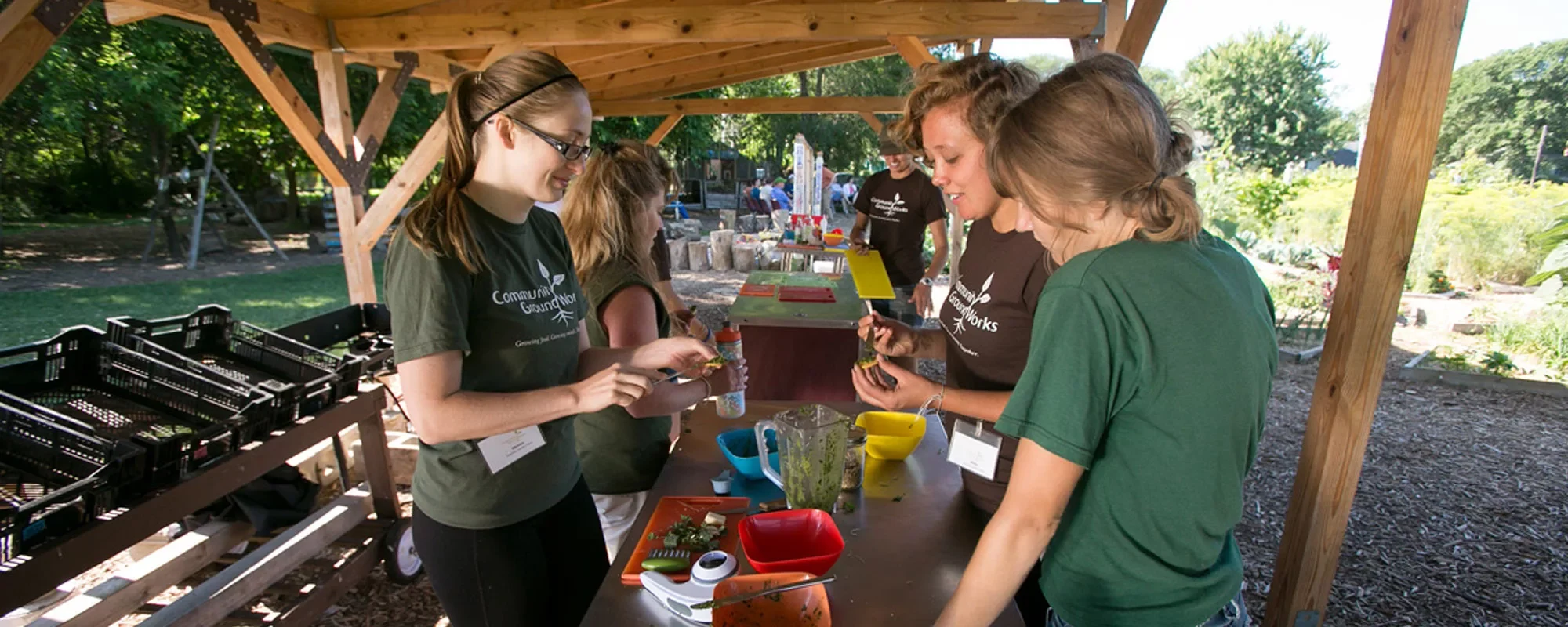
A decade ago, the University of Wisconsin Medical School became the nation’s first school to fully integrate medicine and public health, signifying its dedication to address society’s most challenging health-related problems.
The name change to “UW School of Medicine and Public Health” — approved by the UW System Board of Regents in November 2005 — represented years of work refining the school’s education, research, clinical care and community service missions.
“Our goal is to help shape physicians who think beyond clinical environments, as they consider social, environmental, economic and public policy issues affecting health and health care for populations,” describes the school’s Dean Robert Golden, MD.
Elizabeth Petty, MD ’86, recalls excitement upon watching her medical school alma mater change its name and scope when she was the associate dean of student programs and medical student education at the University of Michigan Medical School. She returned to the UW School of Medicine and Public Health as its senior associate dean for academic affairs in 2011.
“We’ve made tremendous progress and are deeply committed to incorporating public health throughout our curriculum,” says Petty.
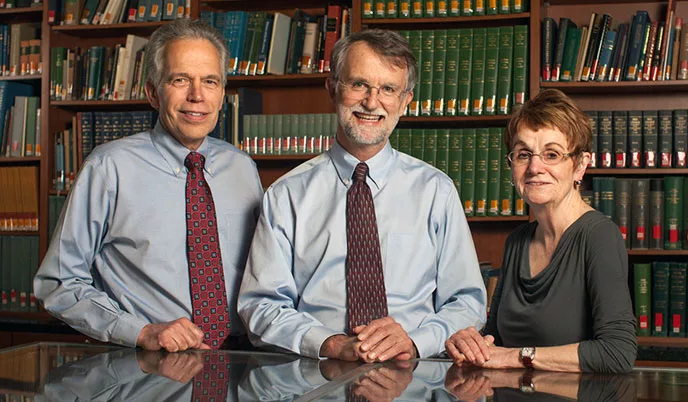
Eileen Smith, Wisconsin Partnership Program (WPP) director, reflects, “We did not intend to change the entire fabric of the school. Instead, we added to it by developing more ways we can benefit people throughout Wisconsin and beyond.”
Adding to that fabric began with a vision. Then-Dean Philip Farrell, MD, PhD (PG ’72), recalls first describing his ideas about the change to David Kindig, MD, PhD, former UW–Madison vice chancellor for health sciences and an emeritus professor in the Department of Population Health Sciences.
“He asked, ‘Is there anything unique you want to accomplish during your deanship?’” says Farrell. “I said I was interested in developing public health within the school, ideally as an integrated school of medicine and public health, but it seemed like a wild dream!”
Clearly, dreams can come true, especially when people work together.
Our goal is to help shape physicians who think beyond clinical environments, as they consider social, environmental, economic and public policy issues affecting health and health care for populations.
- Dean Robert Golden, MD
“I was honored when Dean Farrell tapped me to help launch the Master of Public Health (MPH) program and when Dean Golden invited me to lead the transformation to an integrated school of medicine and public health. The challenge seemed daunting, but I quickly realized many talented people throughout campus were eager to share their expertise and energy,” describes Patrick Remington, MD ’81, MPH, the first associate dean for public health and founding director of the MPH program.
Farrell notes that promoting “the art and science of medicine and the betterment of public health” has been part of the American Medical Association’s mission since 1848, the same year Wisconsin became a state.
He also says, “We were blessed to get Bob Golden as our next dean. Others may have thought the transformation was crazy, but he fully embraced the idea and made it the centerpiece of strategic planning.”
And Golden shares, “I came to Wisconsin believing we could be the nation’s #1 school of medicine and public health. I am pleased to see this effort continue to flourish.”
He stresses that funding and support from the school’s Wisconsin Partnership Program have been catalysts. Resulting from conversion of Blue Cross and Blue Shield United of Wisconsin, WPP awards grants to community-based, nonprofit organizations to address health, well-being and health equity in Wisconsin, and to UW faculty and staff to develop innovative research and educational endeavors that weave together medicine and public health.
The nation took note when the UW School of Medicine and Public Health earned the 2013 Spencer Foreman Award for Outstanding Community Service from the Association of American Medical Colleges. One of the highest honors among medical schools, the award recognizes long-standing commitments to address community needs that are not being met through traditional health care delivery systems.
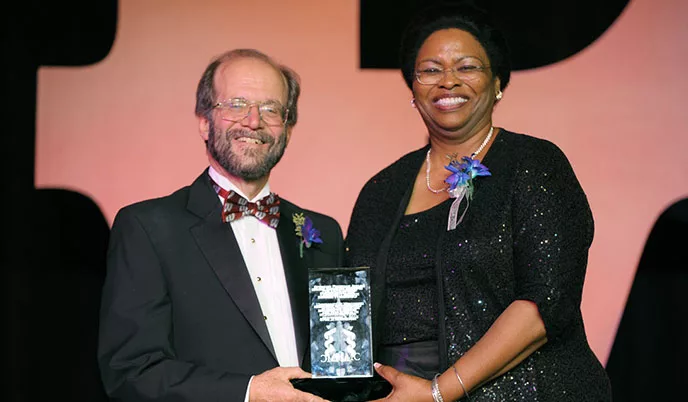
“We have many successful partnerships with community organizations and other places where students get hands-on experiences melding medicine and public health,” notes Remington.
“Also, by carefully considering what future physicians will need to know, our school created programs such as the Wisconsin Academy for Rural Medicine (WARM), Training in Urban Medicine and Public Health (TRIUMPH) and Preventive Medicine Residency,” says Smith.
These complex issues will not be solved solely in a clinical setting, as they require broad societal change.
- Patrick Remington, MD
WPP’s strategic investments — the Lifecourse Initiative for Healthy Families and Obesity Prevention Initiative — address major health challenges in Wisconsin: eliminating disparities in birth outcomes among African Americans and reducing childhood obesity.
“These complex issues will not be solved solely in a clinical setting, as they require broad societal change,” says Remington. “They rely on groups combining strengths to make incremental improvements for society.”
For instance, obesity-prevention efforts may require advocating with city planners to build walking and bicycling paths so people can be active with less risk of injuries.
While the school’s education, research and community service activities span the state and beyond, the school has myriad partnerships in Milwaukee. Some UW School of Medicine and Public Health programs focus their Milwaukee-based activities at community organizations — such as United Community Center and Walnut Way Conservation Corp. — that serve as “hubs” of activity. Research ambassadors and program leaders live and work in the local area and fully understand its culture.
“By strategically working with our partners, we are able to serve diverse populations in ways that benefit all involved,” says Petty, pointing to student service learning projects as examples.
The UW School of Medicine and Public Health leads the way nationally with ongoing curricular innovations that introduce medical students early and often to public health principles and practices. In fall 2016, its entering MD students will experience a completely revised curriculum.
Two optional MD programs — TRIUMPH and WARM — are increasing the number of physicians who practice in medically underserved urban and rural settings, respectively. The programs’ volunteer preceptors train students with the goal of easing physician shortages in those areas.
“In WARM, we experience firsthand what it is like to be a community doctor. The mentorship is phenomenal,” shares Phillip Mercier, MD ’16, who plans to practice in a rural Wisconsin town following his residency.
TRIUMPH graduate Chrissy Ripp, MD ’16, trained in a predominantly Latino neighborhood on Milwaukee’s south side, which has a high rate of obesity in children. As a medical student, she worked with neighborhood groups to launch a summer bike camp to teach children and families safe ways to use bicycles for transportation.
In late 2012, the UW School of Medicine and Public Health received a five-year, $1.2 million Prevention Innovations in Medical Education (PRIME) grant from the U.S. Health Resources and Services Administration. In addition to funding new public health-related electives and interprofessional opportunities for all physician assistant (PA) and MD students, the grant fostered creation of the Path of Distinction in Public Health (PoD).
While any student can pursue an MPH, the PRIME grant supports the MD-MPH and PA-MPH programs. Dual degrees are gaining popularity, explains Parvathy Pillai, MD, MPH, the PoD’s faculty director.
The Path of Distinction complements work being done in other tracks, such as WARM and TRIUMPH, and in programs like the Native American Center for Health Professions. Housed in the UW School of Medicine and Public Health, the center offers innovative ways to train Native health professions students and keep them connected to Native health and wellness.
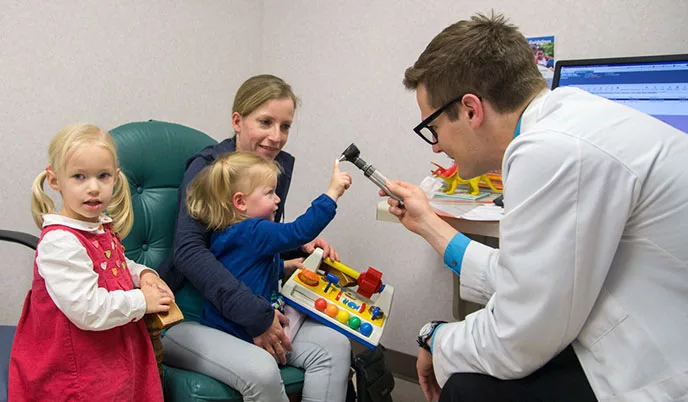
Transforming the research enterprise called for melding biomedical sciences with a focus on epidemiology, biostatistics, social and behavioral sciences, and health policy.
Marc Drezner, MD, senior associate dean for clinical and translational research, led the UW School of Medicine and Public Health in creating the Institute for Clinical and Translational Research (ICTR), calling upon strong WPP support. The UW School of Medicine and Public Health also successfully obtained a national Clinical and Translational Science Award (CTSA), which significantly bolstered its reputation as a leader in integrating biomedical and population health sciences and helped attract key faculty recruits. Ongoing support from the UW Medical Foundation, the faculty group practice, UW Hospitals and Clinics and the UW–Madison Office of the Chancellor has been instrumental in sustaining ICTR, which moves discoveries from the lab to patient care. This is a hallmark shared by researchers at the UW School of Medicine and Public Health’s state-of-the-art Wisconsin Institutes for Medical Research.
Drezner notes, “We have not sacrificed basic science or traditional clinical research. Instead, we have embellished our abilities by looking at topics from different perspectives.”
An example is the work of the Collaborative Center for Health Equity (CCHE), a National Institutes of Health (NIH) Center of Excellence that offers community engagement, research and career development support specific to minority health, health disparities and health equity. Many CCHE-affiliated investigators obtain WPP and other grants to build community-academic partnerships and research programs.
“At CCHE, we help investigators organize and implement projects, and we can connect investigators with others who are working in similar regions or populations,” explains Sarah Esmond, ICTR administrative director.
The center also offers an annual, one-week Health Equity Leadership Institute to help grow the national network of scholars. It teaches postdoctoral researchers and early faculty members how to apply for grants and how applications are reviewed. Its 130 graduates often collaborate after attending.
Richard Moss, PhD, senior associate dean for basic research, biotechnology and graduate studies, looks at the continuum of basic science and clinical trials to patient care and population health as having intersections all along the way. He describes a strong UW–Madison team effort that began when Bruce Klein, MD (PG ’89), professor, Departments of Pediatrics, Medicine and Medical Microbiology and Immunology, received a WPP grant to address the need to find new sources of antimicrobials. Klein began collaborating with researchers from across UW–Madison, including David Andes, MD, PhD (PG ’96), Tim Bugni, PhD, and Cameron Currie, PhD. Andes is a professor and chief of the Division of Infectious Disease, UW School of Medicine and Public Health Department of Medicine; Bugni is an assistant professor in the UW School of Pharmacy; and Currie is a professor of bacteriology in the UW College of Agricultural and Life Sciences. Notable results helped the team obtain a sizable NIH grant in 2014; Andes is the principal investigator.
“In their federal grant’s first year, they had astounding success, nearly equal to discoveries in the past decade nationwide. This is a great example of a huge population health concern being addressed through an interdisciplinary approach,” exclaims Moss.
School leaders also tout the success of the WPP-funded Survey of the Health of Wisconsin, the first statewide research of its kind to measure information on critical health conditions. More than 5,000 adults and children have participated in the survey, from which the UW School of Medicine and Public Health shares anonymous data to help organizations and researchers identify needs and target resources to make the biggest impact.
A story-teller at heart, Remington describes alumni who demonstrate the integration of medicine and public health.
For instance, he points to the success of Jackie Redmer, MD ’07, MPH ’09 (PG ’11, ’13), who — after earning her MD and MPH degrees at the UW School of Medicine and Public Health — completed a residency and integrative medicine fellowship in its Department of Family Medicine and Community Health. She practices family and integrative medicine at Northlakes Community Clinic in Iron River, in one of Wisconsin’s poorest, least-populated regions.
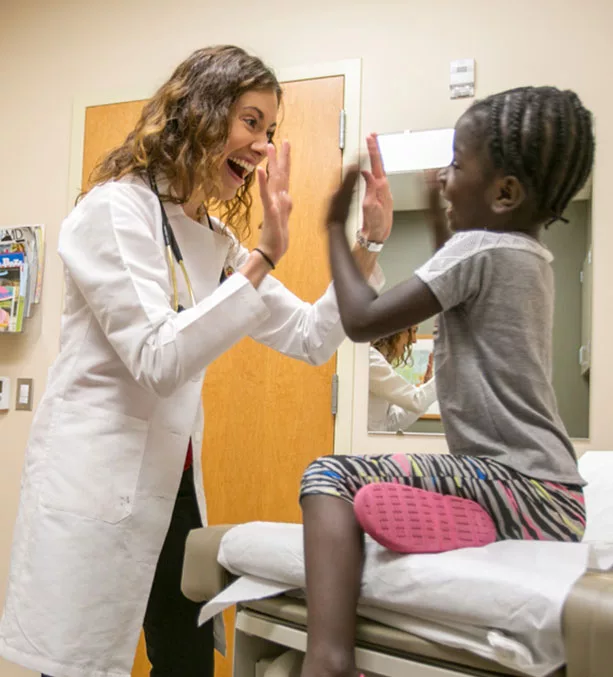
“My patients are economically diverse, ranging from working class and rural low-income individuals, to tourists and artists,” says Redmer. “My day-to-day work feels as much like public health as clinical medicine. My colleagues and I have many community connections and are always looking for ‘upstream’ ways to improve health and access to health care for patients. We enroll them in health insurance and help them find affordable housing and medication coverage. This is the type of practice I envisioned when I was an idealistic medical student.”
Jacqueline Gerhart, MD (PG ’11), shares Redmer’s philosophy and passion.
During her residency at the Department of Family Medicine and Community Health, she practiced at Madison’s Wingra Clinic, which focuses on clinical medicine and public health for underserved populations. There, she began caring for twins Alona and A’lon Willis, and their mom, Toccara Kimball. Gerhart treated Kimball for chronic rheumatic fever that resulted from untreated strep throat as a child in inner-city Chicago.
“Her health care needs are an example of a historical public health concern that has been significantly reduced through enhanced care for strep throat,” notes Gerhart.
“I loved seeing Toccara’s joy when she had her babies, although she was frightened about managing the family as a single mom. We worked with support services to arrange assistance for food, diapers and formula, child care, transportation and vocational advancement,” says Gerhart.
When Gerhart began practicing at UW Health’s Windsor-DeForest Clinic, the family kept her as its primary care provider despite having to drive 25 minutes north of Madison.
“I am blessed to practice and teach at the UW School of Medicine and Public Health,” says Gerhart. “I strive to create lasting and caring relationships with my patients, their families and the community. Toccara’s story is a testament to the school’s community service mission. It is my goal to model this mission in caring for my patients and in teaching future health care providers.”
UW School of Medicine and Public Health faculty and staff recognize that achieving the ultimate public health goal — longer, healthier lives for all—will require more work, particularly because public health challenges require attention from a variety of angles. Smith predicts that WPP will become increasingly involved in policy development that can influence changes in systems and the environment.
“Clearly, we are not going to build bicycle trails or rail systems, but we can provide experts who educate people about why such things are needed. Similarly, the school cannot directly change poverty, but our faculty can describe its impact on people’s health, with the goal of influencing others who can make a difference,” says Smith.
WPP also is exploring ways to incorporate advancement of health equity into future investments. It is hosting a conference on the topic in fall 2016.
Drezner adds that more broadly disseminating and implementing research is a future wave. For example, he cites a WPP-funded Wisconsin Falls Reduction Project.
In collaboration with the Kenosha (Wisconsin) County Division of Aging and Disability Services, Jane Mahoney, MD (PG ’89), professor, Department of Medicine, integrated the evidence-based Stepping On Program into community services. The program, which she brought to the United States from Australia, has reduced falls an average of 40 percent. She and other researchers, working with community partners, have developed a related training program for health care providers that is being used across the nation.
Moss shares, “Transforming a school has as much to do with attitudes and culture as it does with any specific programs you implement. We have built a culture that will help us achieve our vision and goals.”
Referring to the 2015 Wisconsin Health Trends Report, Remington says, “We are making progress, but health disparities are a huge challenge in Wisconsin. Our school’s decade-long transformation has allowed our researchers to gather evidence about what works for communities, and our graduates start careers with ample public health skills to help translate this research into practice.”
He concludes, “The UW School of Medicine and Public Health is committed to continue working with our community partners toward the goal of longer, healthier lives for all.”
* Programs created with funding from the Wisconsin Partnership Program